Facing the negative population growth, you may not have to be so pessimistic
Author:Daily Economic News Time:2022.08.28
The bells of the decline in population are getting closer.
Not long ago, the article published by the "Qiushi" magazine published a party group signed by the National Health and Health Commission of the Communist Party of China, stating that during the "14th Five -Year Plan" period, my country's total population will enter a negative growth stage, and "young son aging" will become the norm.
There are not a few countries facing similar situations. The United Nations "World Population Outlook of 2022" predicts that during 2022 to 2050, more and more countries with a decreased population will be reduced by 1%or more in the population of 61 countries or regions. Based on the hypothesis of medium fertility, the global population will reach 10.4 billion people in 2086.
In a concern about the aging population and the sharp decline in labor, Oded Galor, a professor of economics at Brown University, made a completely different voice. "Unlike them, I think the decline in the global population is the best thing in the history of human beings." He said in a conversation with urban evolution.

Odade Geler Picture Source: Provided by the respondent
How does the "problem" of the population become "good" of the population?
Geller has shifted from the perspective of contemporary society that seemed to be "problematic" to longer human history. He found that the changes in population logic occurred in the past two centuries: not only did the population really enter the period of rapid growth, but the population growth was consistent with the first step of the quality of life. Most of the time, the population growth has exacerbated the difficulty of life -as shown in the "Malassas Trap".
How does our concept of population change? Human beings on the dilemma of "two choices" again? In the newly came out of Geller's new work "Human Tour", his series of views of breaking through thinking inertia may bring us different thinking.

"Human Journey", Odde Geller, translated by Yu Jiang, CITIC Publishing Group, August 2022
Myth of population growth
May wish to return to the most basic question first: how does the population grow?
In order to restore the growth of population more, Geller has drawn a 12,000 -year -long population growth curve. The starting point of the observation is the last 1 0000 BC that it appeared in the latest ice period. Since then, the population has not experienced linear growth, but has three obvious growth periods and three obvious platform periods. The secret of population growth is in the factors of human social change corresponding to the growth period.
It is not difficult to find out in history that the total population growth is highly correlated with technological progress. Taking the first population growth that appeared from 2000 to 4000 years ago as an example, according to Galller, it was the time when most great cities in the ancient world were born at the same time. Further domestication, as well as the improvement of farming, storage, communication and transportation, which is the Neolithic era in history.

In the following two growth periods, it corresponds to 1,000 Vitamin Pirates attacking the Nordic Coast and China for the first time for military primary; and Columbus explored in the Americas in 1500.
Another problem caused by this is why the growth brought by scientific and technological progress is so short? The natural pursuit of population growth of human "profits and avoidance" is one of the reasons.
A representative point comes from Thomas Marsas, author of "Population Theory". Based on the current situation of society in the 18th century, Marsas discovered the "dead cycle" of population growth: the invention of iron plow planting method improved the ability to produce bread. Can support more children and increase the population of the village, but the growth of bread production is limited, so everyone's living standards quickly return to their original level from growth.
Just as Gile concluded that the world has been under the shadow of the "Malassas Trap" for a long time. After the technological innovation has increased to a certain increase in the population, it will always enter the suppression period, and the growing population offsets all material prosperity. In the end, the population growth has reached the innovation limit. Relax stagnation. Until 1800, the population suddenly entered a period of rapid growth.
What happened to this special time point?
As in the past three times, the technological innovation brought about by the industrial revolution is prepared for population growth. But unlike before, the new change has changed the underlying logic of population growth. Geller describes it as a "wheel of change", thanks to the accumulated effects: first, the population size has increased to the degree of innovation that can promote a larger scope, and the other is that as the population cultivates the environment to cultivate stronger adaptability, it is more adaptable. Promote cultural changes -change from chasing the number of population to the improvement of quality to get rid of the "Marsas trap".
Step of dilemma
Focusing attention to the industrial revolution can better understand the nature of population changes in recent years.
In the "Human Tour", Geller abstracted the selection of fertility into the balance of two effects. On the one hand, the "income effect", that is, after the increased income of the parents, will increase the total amount of resources invested in the cultivation of children; on the other hand, the "alternative effect", that is, the income that parents sacrificed for their children instead of work, that is, raising raising The opportunity cost of children.
The dilemma has caused different choices of human beings in different periods. He cited the example of three families to explain:
The first is the 16th -century Irish farmer Kelly family. He has a small piece of land and three children (two children). He can barely support the whole family. A new food comes from the Americas called potatoes, which is much higher than wheat. Planting potatoes really brought a big harvest to the Kelly family, and the money made by selling potatoes allowed Kelly to continue to have children. But because the planting potatoes do not need to learn, children do not read. They still cultivated that small piece of land, had a large population, and fell into poverty. Until 1846, Ireland potato reduced production sharply due to viruses. The second one was the early 19th century England migrant worker Jones. They also had three children (two children and one daughter). Under the industrialized impact, the whole family gave up small farmland and entered the city to work. Tired of work, but the income greatly increased, Mr. Jones took out a sum of money to make his eldest son a technician apprentice, but because of limited funds, the second son who failed to worship was difficult to leave the workshop in his life.
The third is the early 20th century Swedish fisherman Olson's family. Both husband and wife are literate. They borrowed a model from the bank and bought a larger fishing boat through the relationship. They also had three children (two children and one daughter). If the income increases, the child is sent to the noble school. The Olson couple asked them to study hard to get high -paying positions in the future.
It is not difficult to find from the three examples that as the timeline continues to extend, the replacement effect is more than the income effect, and more money is invested in cultivating a few children instead of giving birth to more children.
Observing the various changes since the Industrial Revolution, Geller proposed two main reasons: First, including the increase in the tendency of new opportunities to the educated people, the decline in children's mortality, and the rise in urbanization rate, let parents invest in education education The return rate has risen sharply, reducing the income effect of fertility; the second is that the gap between gender salary has reduced the only channel for women to raise their children to increase value, and then women have risen marriage age and the fertility rate decreases.
In the final analysis, Galller believes that it is the change in the entire scientific and technological landscape, especially the unprecedented replacement speed of technology, so that investing in children's education has become the "must option" of all parents. The industrial revolution has made human capital the most important factor in development, which is the core point of Galler's proposal in the book.
More importantly, with the change of population structure and the improvement of population quality, the quality of personal life has been greatly improved.
The most classic conclusion of the "Marsas Trap" is that population growth has not been able to promote the improvement of life quality. Geller mentioned a set of data: Babylon, Cuba, more than 3,000 years ago, average daily salary of about 7 kg of wheat. By the eve of the industrial revolution, Amsterdam in the Netherlands was 10 kilograms of wheat, Paris, France was 5 kg, Italy's related cities were 3- 4 kg. During 3000 years, personal income has not risen.
In the 200 years since the beginning of the 19th century, the global average income has increased by 14 times. "The fertility rate has decreased, and the quality of life is not the same as the increase in population growth, which also allows humans to open a long period of prosperity." Geller explained.

Different population decline
"The so -called modernization is the overcome of the" Marsas Trap "." Galller concluded.
From the perspective of effect, the logic of the past pursuit of total population has gradually been replaced by the logic of everyone's quality of life. In addition to intergenerational income growth, in Gallle's view, environmental problems that are more seriously troubled by global will also be solved -supplemented by related technologies, and the reduction of population will gradually reduce the pressure on the environment.
Judging from the mechanism of low fertility, no country may escape this trend.
The "World Population Outlook of 2022" predicts that the global population growth will be more than half of the global population growth in 2050 will be concentrated in India, Pakistan, the Philippines, and Egypt, Congo (Gold), Ethiopia, Nigeria, Tanzania and other Asia and Africa countries. However, in Gallle's view, the global scientific and technological revolution that is still deepening will be involved in these countries sooner or later. They will one day face the problems faced by developed countries today.
The government's plan to stimulate fertility will become more difficult. "Over time, the policy cost will become larger, because improving the quality of children is more motivated, income, and more common for parents." He said.
Compared with the decline in population that comes sooner or later, more important issues may be the sequence of different countries entering the turning point. In fact, the earliest European and American countries in the industrial revolution also ushered in the first major population transformation. They not only jumped out of the stagnation era early, but also opened a significant gap with the post -developed countries.
Why are these countries? Geller's fine count includes systems and cultural reasons. In the end, everything can be attributed to geographical factors -in the past crescents fertile areas (editors note: generally refer to the two river basins in West Asia and North Africa, and a series of fertile land nearby) After the agricultural revolution, it was developed, but the favorable factors at that time, such as the vast area and central centralized rule, "lost" in the industrial era that they were more decentralized in Europe. And it is easier to establish an open system.

Even so, Galller mentioned that there were no shortage of accidental incident impact in the face of the seemingly "destined" geographical factors.
In the UK, which originated in the industrial revolution, the black death played this role. It killed nearly 40%of the British Islands residents in the 14th century, which led to the increase in agricultural labor shortage and the improvement of bargaining capabilities, forcing land nobles to increase the proportion of households. This allows British politics and economic power to scattered, and more social groups participate in innovation and wealth creation. The plague also enlarged the system differences between East and Western Europe, making it towards a completely different growth trajectory. On the eve of a new round of change
Right now, the new crown epidemic adds variables to global development.
In Gallle's view, in today's medical and hygiene level, it is difficult for the epidemic to bring the catastrophic effects of the past. However, some changes have indeed happened. Home and offices have stronger labor liquidity, and the global epidemic of the epidemic has also made countries aware that cooperation is the final answer to solving development issues.
On the one hand, despite the inevitable decline in the population, the "wheel of change" can continue to rotate. Galller believes that under the trend of globalization, transnational intelligence exchange is becoming more frequent, and he can often see that scientists between China and the United States communicate with each other and jointly promote scientific and technological progress. Because the total population of the world is large enough, it is difficult to have a global economy backward due to lack of talents.
On the other hand, the role of population diversity on economic development will be more prominent.
Geller had conducted quantitative research on the relationship between diversity and economic development. He found that the changes in the degree of population diversity in different regions show strong correlation with the migration route of Homo sapiens from Africa to the world. The genetic diversity of the local group decreases from Africa.
Based on this as a standard, the relationship curve of per capita GDP, per capita lighting, urbanization rate and homogeneity of population are all obtained. All the humps are obtained, and the hump basically appears in the position of the Asia -Europe continent.
Geller analyzed that this exactly shows a diversified "two sides": a certain degree of diversification is conducive to economic growth, but after exceeding a certain limit, it will bring various conflicts, which is not conducive to political stability.
Different from geographical factors, the economic prosperity brought by population diversity is not unchanged. In Galler's view, through the appropriate policy, it can achieve the effect of exerting its benefits and ease adverse effects.

"For China, a relative homogeneous society caused by geographical conditions requires more education to encourage the mentality of opening up new ideas, the spirit of doubts about things, and the will to change the status quo. surroundings."
Will the decline in population lead to the loss of China's existing competitiveness? Galller believes that it should pay more attention to the proportion rather than the total amount. "Even if China pays attention to the population scale, it is difficult to change the proportion of China's population to the global population if considering the global population reduction trend."
Daily Economic News
- END -
Italy's inflation in June hit a 36 -year high
Xinhua News Agency, Roman, July 1st (Reporter Chen Zhanjie) The report released by the Italian National Bureau of Statistics on the 1st shows that the country's inflation rate in June this year was 8%...
Protests broke out in the U.S. Capital: Anti -abortion supporters burned the national flag on the street, and the police policemen were waiting for

According to the US Fox News, on the 24th local time, thousands of American people...